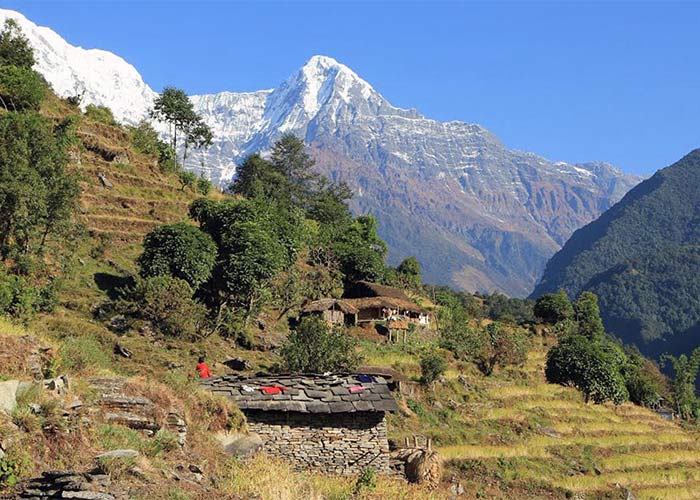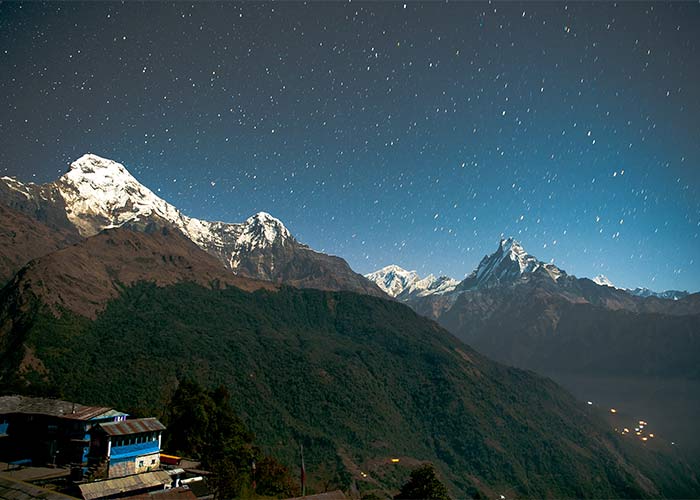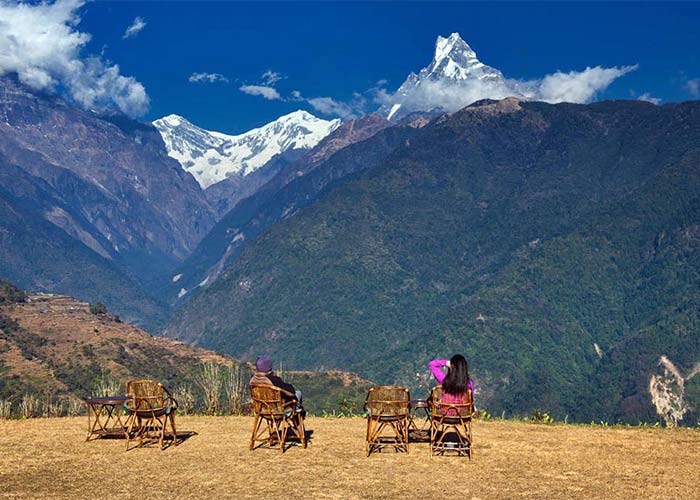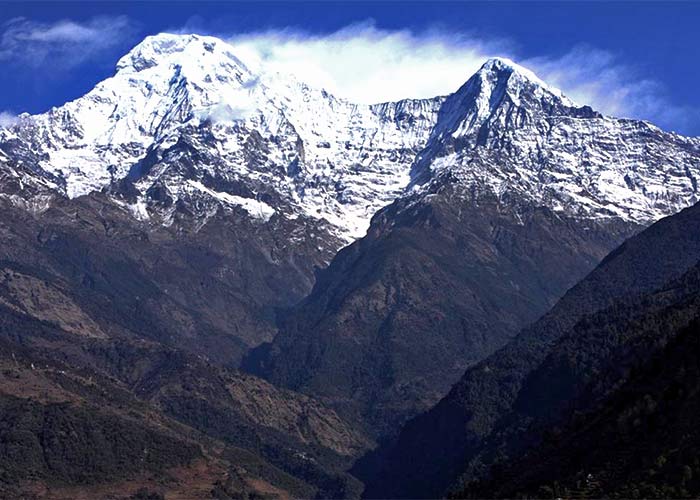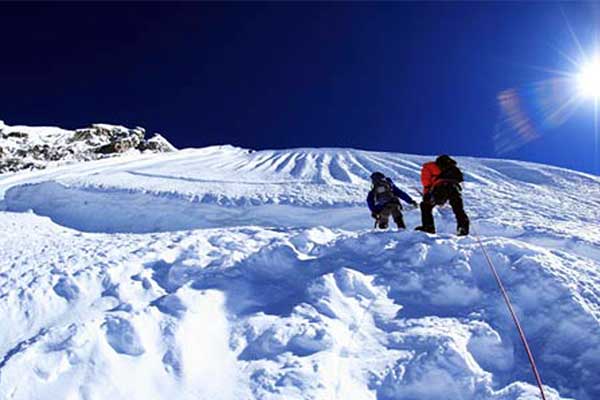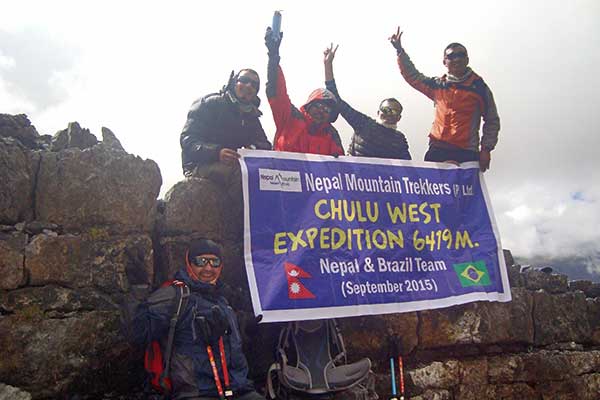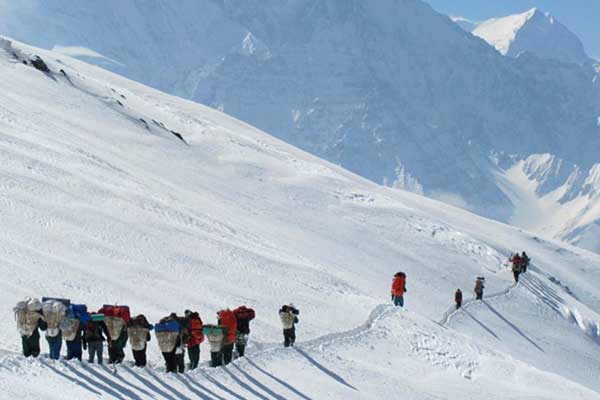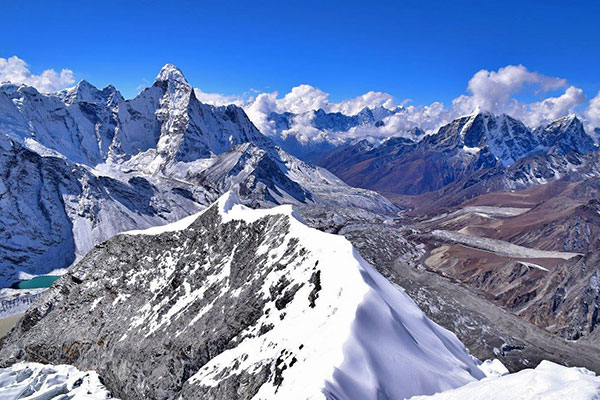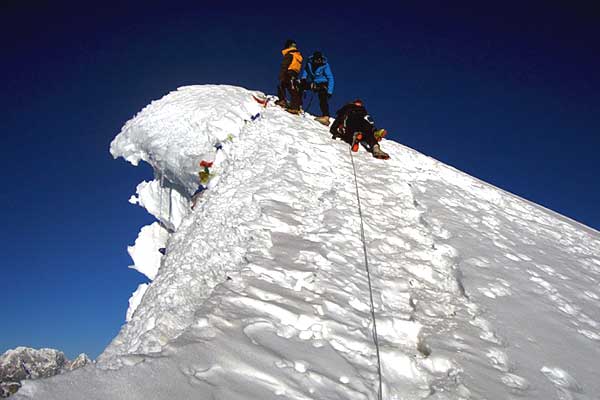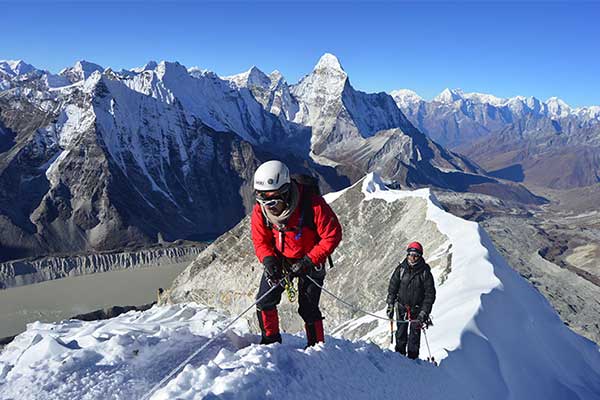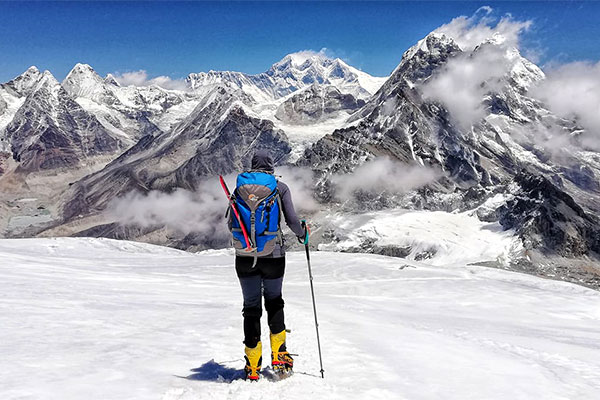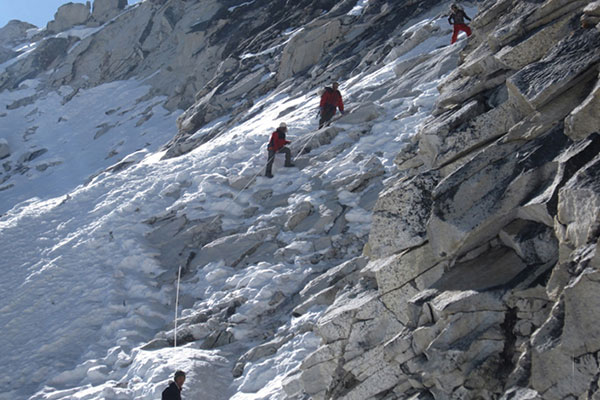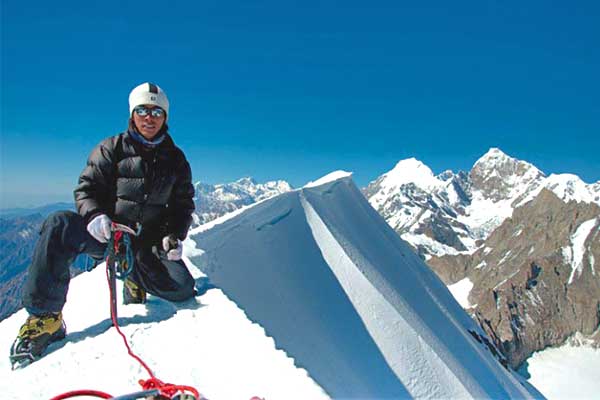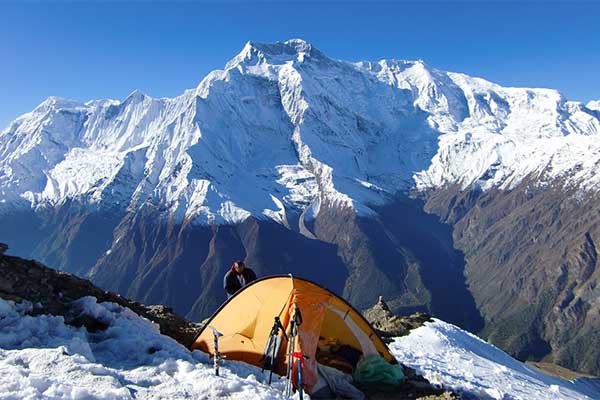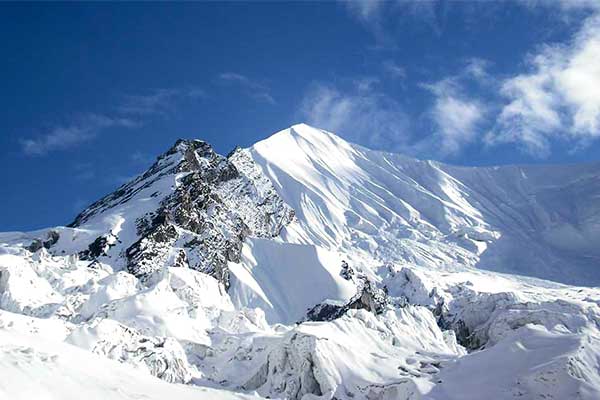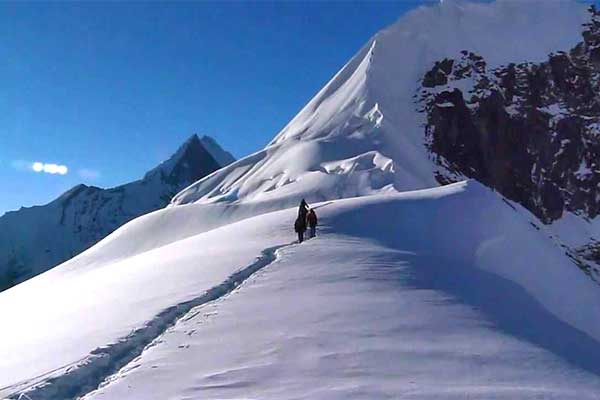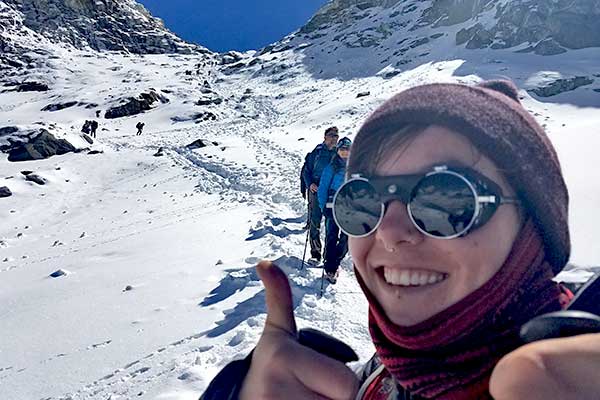Overview
Duration :
18 Days
Secondary Activity:
Nature, Culture and Adventure
Max altitude :
6,441m/ 21,131 ft
Transportation:
Private Vehicle and Domestic Flight
Trip ends in:
Kathmandu
Accomodation:
Lodge and Tent Camp
Primary activity:
Trekking and Climbing
Group Size:
Min. 1 pax
Country:
Nepal
Trip starts from:
Kathmandu
Diffficulty:
Strenuous
Meals:
Nepali and Continental
Best Season:
Autumn and Spring
Trip route:
Kathmandu -Pokhara-Nayapul-Tikhedunga-Ghorepani-Poon Hill-Tadapani-Chhomrong-Deurali-Annapurna Base camp (ABC)-Machhapuchhre Base Camp-Annapurna Base Camp -Hinko Cave-Hinko Cave-High camp -Hinko Cave - Dovan-Jhinu danda-Pothana-Dhampus- Phedi-Pokhara -Kathmandu
Trip introduction
Hiunchuli Peak Climbing is an adventurous way of summiting Hiunchuli Peak attached to the Annapurna Himalayan Range. And along the way, we also get to experience Ghorepani Poon Hill, Annapurna Base Camp, and Dhampus trekking that truly redefines the natural and cultural aspects of trekking in the Annapurna region. American Peace Corps team first summated the Hiunchuli peak in 1971 via the south face. And the same route has been mostly followed since then. This Peak is not a technical climbing peak but it comes with the risk of avalanches and rockfalls.
Hiunchuli Peak Climbing starts as we drive from Kathmandu to Pokhara followed by the initiation of the trek from Nayapul. Making our way through Ghorepani Poon Hill with mesmerizing sunrise views over the Himalayas, we head towards Annapurna Base Camp via Macchapuchre(Fishtail) base camp and to Hinko cave. Then we set up a high camp and summit Hiunchuli peak on the 12th day of the trip. After summiting the peak at an altitude of 6441 meters, we return to Hinko Cave on the same day. And finally, we trek through beautiful Gurung inhabited villages like Dhampus, Pothana and get back to Kathmandu from Pokhara.
The best time to go for Hiunchuli Peak Climbing would be during the spring months from March to May and during the autumn months of September, October, and November. You must be in good physical fitness before joining this trip. Therefore, join Hiunchuli Peak Climbing with Nepal mountain trekkers for professional arrangements in a safe manner. Contact us now for booking and further information on any of our trips.
Special Note:
If this itinerary doesn’t suit your requirement or if you want to customize it, please feel free to contact us. This trek could be customized as per your required time frame and budget limits.
Overview
-
Day 1Arrival Kathmandu. (1,350m/4,428ft):
-
Day 2Kathmandu Sightseeing & Preparation for the Climbing:
-
Day 3Fly/Drive Kathmandu to Pokhara (820m/2,960 ft): 5-6 hrs by bus / 35 minute by flight:
-
Day 4Drive from Pokhara valley to Nayapul (1,020m/ 3,346 ft) 1.5 hrs and trek to Tikhedunga (1,577m/ 5173 ft): 3-4 hrs:
-
Day 5Tikhedunga to Ghorepani (2,675m/8,776 ft): 6-7 hrs:
-
Day 6After enjoying early morning hike to Poon Hill (3,180m/10,433ft) for sunrise view we trek to Tadapani (2,675m/ 8,776 ft): 6-7 hrs:
-
Day 7Tadapani to Chhomrong (2,170m/7,120ft): 5-6 hrs:
-
Day 8Chhomrong to Deurali (3,230m/10,595ft): 6-7 hrs:
-
Day 9Deurali to Annapurna Base camp (ABC) (4,130m/13,545ft) via Machhapuchhre Base Camp (3,700m/12,135ft): 5-6 hrs:
-
Day 10Annapurna Base Camp to Hinko Cave (3,400m/11,154 ft): 5-6 hrs:
-
Day 11Hinko Cave to High camp (5,900m/ 19,356 ft): 5 hrs:
-
Day 12Summit day (6,441m/ 21,131 ft), Back to Hinko Cave:
-
Day 13Hinko Cave to Dovan (2,630m/8,628 ft): 5 hrs:
-
Day 14Dovan to Jhinu danda (Hot spring): 5-6 hrs:
-
Day 15Jhinu Danda to Pothana (1,600m/5,249 ft)/Dhampus (1,770m/5,807 ft): 6-7 hrs:
-
Day 16Pothana/Dhampus to Phedi (1,130m/3,707 ft) 3 hrs and drive to Pokhara 30 minute.:
-
Day 17Fly/Drive from Pokhara to Kathmandu.:
-
Day 18Departure Day:
Detail Itinerary
Day 1 : Arrival Kathmandu. (1,350m/4,428ft)::
As you land in the Tribhuvan International Airport, Kathmandu the journey to the beautiful Hiunchuli Peak gets started. Complete the formalities in the customs of the airport and you will then be received and greeted by our representative. You will then be transferred to the hotel in a private vehicle for your comfortable stay where you will be given rest to your jetlagged body. Take your time in the hotel to relax and get refreshed. In the late afternoon, you may stroll around in the streets of Thamel and observe the lifestyle of the local Newar community. Enjoy the authentic Nepalese cuisine and warm hospitality in the hotel. Get prepared for the sightseeing tomorrow and get your documents ready for the pre-trip meeting as well. Stay overnight in Kathmandu.
Day 2 : Kathmandu Sightseeing & Preparation for the Climbing::
Have a relaxing day as you shall be exploring the rich and ancient heritages of Kathmandu valley which includes some UNESCO World Heritage Sites as well. The old royal palaces at the heart of Kathmandu and Patan Cities that has a big complex with ancient temples and statues, intricate wood carvings in the pillars of temples, taps, and resting places, and museums belonging to the medieval ages are a big treat to the visitors. The exploration of other pilgrimages such as Pashupatinath Temple (a sacred Hindu Temple worshipped by Hindus all over the world), Swayambhunath Stupa (the 14th-century Buddhist stupa also known as the Monkey Temple), and Boudhanath Stupa (one of the biggest stupas in the world) are all an enriching experience to make time-travel to the ancient history of Nepal. After the exploration, you shall be having a pre-trip meeting for the preparation of climbing where you shall be interacting with the climbing guide about the climbing. Use this opportunity to clarify your doubts regarding the Hiunchuli Peak climbing. Stay overnight in Kathmandu.
Day 3 : Fly/Drive Kathmandu to Pokhara (820m/2,960 ft): 5-6 hrs by bus / 35 minute by flight::
For the climbing of Hiunchuli Peak in the Annapurna region, we shall be heading to the beautiful Pokhara city, the tourism capital of Nepal and adventure hub bordering the Annapurna region. The journey to Pokhara may be made by 5-6 hours of journey by road in a private vehicle or a comfortable tourist bus. The overland journey takes you along the banks of some of the popular rivers in Nepal, the Trishuli River popular for rafting, and the Marshyangdi River. En route the travelers get to experience the beauty of cool waterfalls, changing landscape, rural settlements and the lifestyles within these villages, views of the rolling hills and the glittering mountains overlooking the entire journey, and the warm hospitality of the locals. You shall be welcomed by Fishtail Mountain as you approach the lake city of Pokhara. The short flight to Pokhara is equally enthralling and beautiful. Travelers fly over the vast landscape and lush valleys, high and rolling hills, mighty and perennial rivers, and the close-up view of humongous and glittering silver mountains as they reach Pokhara. Get escorted to the hotel and later you may stroll around the Lakeside and Phewa lake. Stay overnight in Pokhara.
Day 4 : Drive from Pokhara valley to Nayapul (1,020m/ 3,346 ft) 1.5 hrs and trek to Tikhedunga (1,577m/ 5173 ft): 3-4 hrs::
The actual trekking in the region, a concrete step towards the climbing of the peak, starts today. However, initially, we shall head for Nayapul which is the actual beginning point of our trekking and climbing expedition after the drive of around 1.5 to 2 hours. Along the Pokhara-Baglung highway, we shall drive past some of the popular settlements in the region such as Hemja, Phedi, Naudanda, Lumle, and others, the popular Hindu pilgrimage of Bindyabasini Temple, and the view of snow-capped mountains all along the drive. After meeting with the other member of the crews and getting our bags packed and ready, we shall begin our trek. The destination for today is Tikhedhunga. Starting from Nayapul, we shall trek ahead past the freshwater rivers, the beautiful and buzzing village of Nayapul, and descend through a couple of bridges and stone stairs along the Modi River to reach the checkpoint in the Birethanti village, along the confluence of Modi and Burugdi Rivers. The trek now is accompanied by the beautiful Bhurungdi River till Tikhedhunga. We walk past the terraced cultivation lands with Rice or Wheat that turns golden on being ripe, lush, and green hills and houses perched on the hillsides, waterfall, forests adorned by beautiful rhododendron forest with mosses as well and the stone stairs. Bhurungdi River parts way near Hille village as we move ahead along the wide stone trail to reach the destination of Tikhedhunga. Overnight stay in Tikhedhunga.
Day 5 : Tikhedunga to Ghorepani (2,675m/8,776 ft): 6-7 hrs::
The trek along this beautiful section continues today as we leave for the ancient trading stoppage point of Ghorepani. In the beginning section of today’s trek, we shall begin with the steep trek to Ulleri village along with the stone steps, around 3200 in number, which shouldn’t be of many problems once you find the rhythm. Don’t forget to marvel at the sight, breathtaking and pleasant, with the view of lofty peaks and lush green hills, and also watch out for the caravan of locals with their cattle in this trek of around 2 hours. Get welcomed to Ulleri by the simple gate put on by the local tourism committee as you shall be resting a bit for the lunch. Enjoying good views of the Annapurna South and Hiunchuli Peak, our ultimate destination, we trek ahead. The ascent continues till Banthanti, a Magar village, which provides spectacular views of the Himalayas and marches ahead to cross the Bhurungdi River to reach some tea shops en route. The trek continues as we climb ahead to the village of Nangethanti and continuing all along the trail we reach the Ghorepani village. Ghorepani is famous for being a hub for trekkers and climbing heading for various destinations in the Annapurna region. We also have views of Dhaulagiri, Annapurna I, Annapurna South, Hiuchuli, and other neighboring peaks from Ghorepani besides the green lush surrounding and typical hilly settlement. Stay overnight in Ghorepani.
Day 6 : After enjoying early morning hike to Poon Hill (3,180m/10,433ft) for sunrise view we trek to Tadapani (2,675m/ 8,776 ft): 6-7 hrs::
You shall have one of the much-awaited trekking sections of this entire expedition today, as we shall be heading before dawn to witness the magical view of sunrise from Poon Hill. Under the blanket of stars with the path lit by moonlight, we leave for Poon Hill for the view of sunrise. After trekking for about 45 minutes we reach Poon Hill, a hill named after the local Pun community. Securing the perfect spot for the view, trekkers get their cameras ready and in position. Slowly orb of the sun starts coming into sight; starting with the outline of the mountains and the crevasses, deep valleys and rolling hills, sparkling of the mists and clouds due to the reflection of the sunrays, viewers finally get the sight of Sun peeping over the mountains and painting them with its golden color. The sunrise over Dhaulagiri mountain (8,167m), Annapurna massifs, Nilgiri Mountain (6,940m), Tukuche Mountain (6,920m), Varah Sikhar Peak (7,847m), Lamjung Himal (6,931m), and many other peaks is truly an outstanding view. Descending from the viewpoint of Poon Hill, we shall have lunch and head for Tadapani village. The descent to Tadapani, with a short steep up of half an hour, takes us through the rhododendron forest with a glimpse of wild animals, such as Langur monkeys climbing through the trees. The trail also takes us through the village of Banthati where trekkers generally stop for lunch. After some trekking further, you reach Tadapani, the Land of Rhododendron, and one of the famous trekking destinations in the Annapurna Conservation Area. From Tadapani, we can get views of mountains such as Annapurna II, Annapurna South, Fishtail Mountain, and other peaks. Stay overnight in Tadapani.
Day 7 : Tadapani to Chhomrong (2,170m/7,120ft): 5-6 hrs::
Start the day with the magical sunrise over the mountain peaks of Annapurna South, Hiunchuli, and others and continue for Chhomrong. We start today’s trek with the downhill walk of around 45 minutes through the rhododendron forest (it seems magical when the flowers blossom) as the trail pop out of the forest to the farming-style landscape of the beautiful Chuile village. Continue the way down the village through the tea shops to cross the Kimrong River on a wooden footbridge and climb up to the settlement of Gurjung where trekkers usually stop for lunch. Villagers transport the food and other materials to this place from Pokhara. In a trail that elevates gradually, the trail leads us past the waterfall and through the high ridges with beautiful views of the mountains and surrounding landscape, settlement perched on the hillside, waterfalls and suspension bridges, terraced farmlands, and stone staircase, and the sight of big boulders. Joining the trail from Landruk near Salaphu village, we shall trek through Nayagaon village to reach the destination of Chhomrong village, a Gurung village. A village built on terraces, Chhomrong has telephone and internet facilities as well for the visitors. Stay overnight in Chhomrong in a teahouse.
Day 8 : Chhomrong to Deurali (3,230m/10,595ft): 6-7 hrs::
Today’s trek starts with descending to the Chhomrong River and after that, the trail leads gradually to the small settlement of Tilche. The walk in the trail continues as we trek past some small settlements before reaching Sinuwa village, one of the stoppage villages in the trail, that provides the view of Annapurna Mountain and the Ghandruk village. After Sinuwa, the unofficial gateway to the Annapurna sanctuary, we continue our trek through the Orchids and fern forest and reach the Kuldi Ghar after trekking for about 2.5 to 3 hours. Further on, there is a clearing in the forest and the trail descends to the settlement of Bamboo through a steep trail with a stone trail which levels out running through the thickets of bamboo at the bottom of the gorge. Trekkers cross the small Pola River and avalanche chutes and walk through the long steep stone staircase, a canyon muddy trail, past the huge rocks, settlements of Dobhan and Hinku, sacred Barahi Temple, interesting Hinku Cave, and beautiful waterfall before reaching the destination of Deurali. Stay overnight in Deurali.
Day 9 : Deurali to Annapurna Base camp (ABC) (4,130m/13,545ft) via Machhapuchhre Base Camp (3,700m/12,135ft): 5-6 hrs::
The climb from the small hamlet of Deurali begins on the right bank of the river and continues along the rugged path on the hillside of the rocky cliff. This path turns slippery at times which turns out prone to avalanches in the winter season. Trek leaders can’t monitor the situation in this part of the trail from below making this section risky in the winter. There can be lots of moraines at the bottom of the cliffs. From this place, the trail turns out to be rather easy and flat and remains the same till we reach the base camp of Machhapuchhre Mountain or the Fishtail Mountain. With few tourist lodges, this is the stoppage point for the trekkers before they head for the Annapurna base camp. We have the view of majestic Fishtail Mountain up close beside the other lofty mountains of Annapurna I and III, Annapurna South, Gaganpurna, Hiunchuli, and others, a rewarding experience. Moving ahead of the camp we start noticing sparse vegetation and widening trails as we enter the Annapurna sanctuary and part away from the valley that we seem to follow for so many days. We turn towards the base camp passing through the moraine of the glacier and the cliffs as we reach the Annapurna base camp. From the base camp, we again get to witness the majestic Fishtail Mountain, Annapurna massifs, Hiunchuli Peaks, and others without any disturbances. Marveling at the breathtaking sunset over the Himalayas, we have an overnight stayed in the Annapurna Base Camp.
Day 10 : Annapurna Base Camp to Hinko Cave (3,400m/11,154 ft): 5-6 hrs::
Wake up amidst the glittering Himalayas and watch the golden rays of the sun painting the white snows of the mountains in one of the most beautiful sunrises in the Himalayan region. After this magical moment, we retrace our steps back in the trail beating the same steps we followed in our climb to the base camp. The downhill trek from base camp shouldn’t be much difficult, though care is to be taken not to put much strain on your knees and ankles in this rocky terrain. Trekking for a couple of hours and turning right towards the Machhapuchhre Base Camp, we join the company of Modi River and cross the glacial river, and trek to the settlements of Bagar and Deurali through some steep ravine, rocky trail, and avalanche-prone area before reaching the destination for today, Hinko Cave. Stay overnight near Hinko Cave in camp.
Day 11 : Hinko Cave to High camp (5,900m/ 19,356 ft): 5 hrs::
Today we reach one step closer to our ultimate destination of ascending the Hiuchuli Peak, which has been attracting us the whole trail during this expedition. The trek on the previous day and the trek to Annapurna base camp served as the acclimatization for climbing this peak. Beginning with the interesting Hinko Cave trekkers slowly and cautiously ascend to the High Camp. You shall have the view of majestic glaciers and humongous mountains and climb on the rocky glacier path. Get used to the use of ice axe, crampons, and ropes so that you don’t get problems during the ascent. View of Annapurna I, Fishtail Mountain, Singu Chuli Peak, Tent Peak, and many more are visible from the High Camp. Stay overnight at High Camp in a tent and prepare your equipment for the ascent tomorrow.
Day 12 : Summit day (6,441m/ 21,131 ft), Back to Hinko Cave::
The ultimate destination of this trek is ahead of you. We start early from the High camp towards the summit. Enough acclimatization makes the ascent easier and you should make the ascent in a decent weather window. Fixed ropes are placed on some of the steeper sections of the route. Much of the ascent is done while moving together as roped teams. Though the ascent isn’t very steep in most of the sections during this ascent, fresh snow makes the climb very tough which is to be taken care of. In a slow and careful ascent, you shall reach the top of the peak. From the summit, the scenery is marvelous. Guarding the entrance to Annapurna Base Camp, this peak stands overlooking the Modi River. The view of the Himalayas including the Fishtail Mountain, Annapurna massifs, Singu Chuli Peak, and many other big and small peaks is seen. Capturing the moment, you need to descend gradually to the High camp. Further, you shall make your way to the Hinko Cave and take a much-needed rest. Celebrate this achievement of yours with your fellow members and relish every moment of the day. Stay overnight near the Hinko Cave.
Day 13 : Hinko Cave to Dovan (2,630m/8,628 ft): 5 hrs::
Today we shall leave the Hinko cave; it has been used by the trekkers and porters as a shelter for long and therefore the overhangs are fire-blackened. Trekkers continue their slow and gradual downhill trek through the dense forest, finding the occasional glimpses of wild animals such as monkeys climbing through the trees. The trek is mostly through the edge of the hills along the valley side, the trekker though finds a place with a collection of lodges in place of Himalaya and past the waterfalls, the sacred Hindu temple of god Baraha, they reach the destination for today, the settlement of Dovan. This trek of 5 hours also gets trekkers to encounter the canyon muddy trail in some seasons. Stay overnight in Dovan.
Day 14 : Dovan to Jhinu danda (Hot spring): 5-6 hrs::
As you continue with your descent to the lower altitude, you shall notice more lush landscape and greenery and feel more ease during the trek. Leaving the settlement of Dovan, you shall continue along the trail accompanied by the Modi River below the trial. Marching along the long and steep stone staircase and crossing the Pola River in between, you shall reach the Bamboo, a place known for lush green views and bamboo forest as well as a stoppage for guest house trekking. Ascend shortly to the Khuldighar, a place with a helipad used generally for emergency evacuation and other purposes, and then trek down to the village of Sinuwa through the orchid and fern forest. After having the view of Annapurna massif and Ghandruk village from this place, you shall head down to the village of Chomrong through the settlement of Tiliche. Cross some streams, explore the smaller settlements before walking on the steep trail past Salaphu to reach Jhinu Danda. Phew! Go for the natural hot water springs in Jhinu Danda, which is supposed to have healing capacity against skin diseases such as ache. After relaxing at the hot water springs, rest at the local teahouse. Stay overnight in Jhinu Danda.
Day 15 : Jhinu Danda to Pothana (1,600m/5,249 ft)/Dhampus (1,770m/5,807 ft): 6-7 hrs::
Start bit lengthy trek of today with the descent to the Kimrong River and past the huge boulders to cross the Modi River at the New Bridge. Continue the downhill trek through waterfalls, settlements of Himalpani, Siuli, Bhirkuna, and have an ascent to reach the famous Landruk village. This Gurung settlement hosts a unique arrangement of houses, well-preserved cultural and traditional heritages, scenic views of the snow-clad peaks, and rolling hills. You shall trek further after crossing small streams, walking through stone staircases, past the Chortens and prayer flags, and suspension bridge to reach the scenic Tolka village after some uphill climb. Continue the ascent through the flagstone steps to reach Pritam Deurali and witness the view of Annapurna South and Hiuchuli Mountain. The stone-paved trails continue in this trail as the trekkers have an uphill climb to Bhichok Deurali and descent to the village of Pothana, a beautiful village that provides a marvelous view of the unique Fishtail Mountain. En route, you trek through the beautiful oak forest as well. Depending on the strength remaining with you, we may head for Dhampus via Australian Camp and Deurali village. In the latter case, you shall encounter ups and downs in the trail with stone-paved trails, Chortens, and prayer flags during the trek. Stay overnight in Dhampus.
Day 16 : Pothana/Dhampus to Phedi (1,130m/3,707 ft) 3 hrs and drive to Pokhara 30 minute.::
If we stay overnight in Pothana, the trek starts with an hour of the trek to the beautiful Dhampus village. One of the most picturesque villages in the entire region, Dhampus provides breathtaking views: the snow-capped mountains shining and overlooking the layers of high and rolling hills, the settlements preserving unique culture since ages lie below the hills and perennial rivers, farm terraces, and forest decorate the vast landscape. All of this seems to be fit in a single picture. Amazing sunrise and sunsets over the mountains seemingly up close add beauty to the scenery. Trek through the rhododendron forest, terraced farmlands, and majestic views of the Himalayas to reach the settlement of Phedi to put an end to our trek and climbing expedition before driving back to Pokhara. Relax in the hotel after 30 minutes of drive and stroll around the streets of Pokhara, especially in the beautiful Lakeside in the latter part of the day. Stay overnight in Pokhara.
Day 17 : Fly/Drive from Pokhara to Kathmandu.::
This day marks the end of the exciting, enthralling, diverse, and adventurous journey into the Annapurna region and climbing the Hiunchuli Peak as we return to the Kathmandu valley. The return journey shall be equally entertaining to the trekkers who shall get relaxed after witnessing the greenery, changing landscape, torrential rivers, cool and beautiful waterfall, and view of the glittering and sky-piercing mountains. Traveling by road gives you the opportunity to interact with the warm and welcoming locals and taste the local delicacies en route. You may also have a short and scenic flight to Kathmandu over the beautiful landscape which is interesting and entertaining every time. Stay overnight in Kathmandu.
Day 18 : Departure Day::
Your Hiuchuli Peak Climbing comes to an end today. Climbing the peak and exploring the naturally and culturally rich region leaves you with the memories to be cherished for a lifetime. We hope that this adventurous journey has tempted you to be back in this nation of diversity, natural wonder for another time as well. You shall be transferred to the Tribhuvan International Airport for your flight to the onward destination. If time remains, you may go for some last-minute souvenir shopping for the near and dear ones in your native place. We wish for your safe and comfortable journey ahead and hope to welcome you again and again in this Himalayan nation.
Price Includes
- Airport Pick up and drop
- 3 nights Hotel in Kathmandu (Hotel Green Horizon or similar standard)
- All accommodation during the trek in the best hotels/tea-houses in the area (differing according to the price you wish to spend)
- Sanitation: The accommodation we provide will be neat and clean with warm-hospitality and quality services.
- Single Accommodation: You won’t have to share your accommodation with anyone else so that your privacy is protected.
- All foods during the trek: Breakfast, Lunch, and Dinner; any items on the menu as much as you wish to consume.
- We provide hygienic and safe meals to re-energize you.
- We request you not to waste your meals for it is difficult to transport food in the rural area.
- You are not allowed to share your meals with anyone else from another group.
- All required camping equipment
- Domestic Flights and all required land transportation
- Professional and Highly experienced English-speaking Trekking Guide licensed by the Government. Including their lodging and food.
- Local Staffs: Our guides are locals of the region which ensures that you will surely get to explore a bit more during the trek than with any other guides.
- Experienced: With an experience of more than a decade of working in this field, our trekking guides possess excellent knowledge on briefing during the trek as well as they are experts in handling all kinds of critical situations which might occur during the trek.
- Insurance: Nepal Mountain Trekkers have an insurance policy for all our trekking staff.
- Porters (1 porter for 2 trekkers with a max load of 25 KG). Including their lodging and food.
- Local Staffs: The porters we hire belong to the same region where we trek in order to provide employment opportunities to the locals as well as to make you explore every prospect of the region.
- Well experienced ice climbing guide (Climbing service charge, insurance, food, personal equipment)
- Group Climbing gear fixed rope, main rope, ice axe, zoomer, harness, the figure of eight, carabineer
- Four seasonal sleeping bags, down jacket, Nepal Mountain Trekkers duffer bag, t-shirt, and trekking map (Note: down jacket and sleeping bag are to be returned after trip completion)
- Peak Permit Royalty, Annapurna Conservation Area Entrance Fee
- Rescue Arrangement Service
- A comprehensive medical kit
- 13% VAT and 10% service charges
- Farewell Dinner
Price Excludes
- Nepalese visa fee (Visa Information)
- International airfare to and from Kathmandu
- Excess baggage charges
- Lunch and evening meals in Kathmandu and Pokhara
- Extra night accommodation(s)
- Travel Insurance and rescue cost
- Personal expenses (phone calls, laundry, bar bills, battery recharge, extra porters, bottle or boiled water, shower, etc.)
- Personal trekking and climbing gears
- Tips for guides and porters
Equipments
 Equipment List
Equipment List
- Duffel Bag
- Day Pack (35-45 L)
- Sleeping Bag (-20F/-30C recommended)
- Down Jacket
- Trekking Boots
- Crocs (evenings & washing)
- Trekking Pants (2-3)
- T-Shirts (3)
- Long-sleeve Trekking Shirts (2-3)
- Trekking Jacket
- Gortex (or similar) Jacket & Pants
- Fleece or Thermal Top (evenings)
- Fleece or Thermal Bottoms (evenings)
- Lightweight Long Underwear (to sleep in or layer under clothes)
- Socks (5)
- Gloves (lighter & heavier for passes)
- Wool Hat
- Baseball Cap or Wide-brimmed Hat
- Camp Towel
- Trekking Poles (optional, recommended)
- Down Booties (optional, recommended)
- Sunglasses (2)
- Water Bottles | Nalgenes (2-3)
- Bladder (optional, recommended)
- Toiletries, Sunscreen with SPF, Lip Balm with SPF
- Watch (with alarm)
- Extra Batteries
- Battery Chargers
- Head Lamp (2)
- Yak Trax (for treks with icy passes)
- Water Purifying Tablets, Small Water Filter or Steripen
- Camp Washing Bowl (optional, collapsible for clothes)
- Laundry Detergent (Kathmandu) or Bio-degradable Clothes Soap
- Hand Sanitizer
- Small Solar Panel (optional, recommended for iPods, iPhones, camera batteries, Kindles)
- Book(s)
- Zip-Lock | Plastic Bags
- Soft Toilet Paper | Tissues (we supply toilet paper but you will want something softer for blowing your nose)
- Baby-Wipes | Wet-Wipes (for personal cleaning)
- Handi-Wipes, J-Cloth, or Chux (optional: easy for a quick daytime clean, fast drying)
- Rehydration | Electrolytes
- Snacks!
- Personal Medical Supplies
- Available in Namche Bazaar
- Snacks, chocolate bars, energy bars (Western brands), dried fruit & nuts
- Laundry Detergent
- ALL trekking gear (Sherpa Gear, Mountain Hardwear, Tsetang’s Gear Shop all have real gear), real & knock-offs.
- Lemon Tang (for water if you want)
- Batteries
- Trekking Poles
- Micro Spikes
- Medical Supplies
- We strongly suggest bringing Western meds with you as there are a lot of Indian fakes on the market!
- Suggested: Diamox, Azithromycin, Ciprofloxacin, Tinidazole, or Flagyl & Augmentin. Bring COMPEED for covering blisters & good tasting electrolytes &/or rehydration salts (Emergen-C is a good American brand). The local versions aren’t very appealing.
- We also recommend bringing strong knee & ankle supports & braces, ACE bandages for sprains & strains, Tegaderm &/or other would coverings. Duct tape is always useful. We’re happy to take excess medical supplies off your hands when you leave if you won’t need them and pass them on to others. We use lots of the large amount we have with us to treat locals we meet when trekking.
Related Trips
You will also like …
